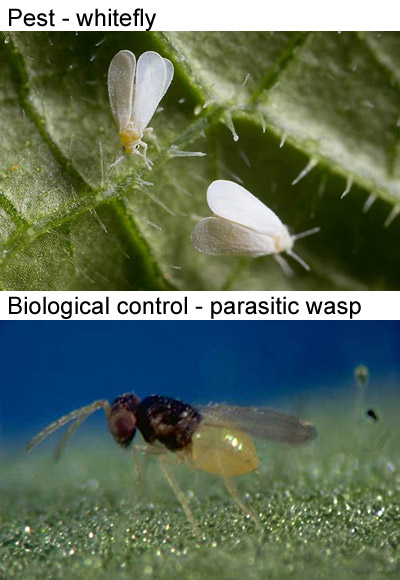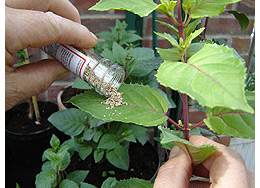 Whitefly - plant pest
Whitefly - plant pest
Signs - Most commonly found on houseplants and in greenhouses, when disturbing the leaves, the tiny white flies that hide under the leaves will fly up. May be found on vegetable crops outdoors in warm weather.
Damage - Sap suckers, will weaken the plant and make it susceptible to further attacks of pests and disease. They can have a surprising effect for such a small fly.
Treatment:
![]() Tap the leaves and, as a cloud of flies up, suck them
up with a small battery vacuum cleaner - take care! or you'll
damage the leaves.
Tap the leaves and, as a cloud of flies up, suck them
up with a small battery vacuum cleaner - take care! or you'll
damage the leaves.
![]() Avoiding whitefly on tomatoes without the use of
chemicals. Plant French Marigolds (Tagetes) between
your tomato plants to keep whitefly away. It's not that the
whitefly particularly don't like these marigolds, it's because
the pungent smell from the marigolds masks the smell of
the tomatoes that usually attract the whitefly.
Avoiding whitefly on tomatoes without the use of
chemicals. Plant French Marigolds (Tagetes) between
your tomato plants to keep whitefly away. It's not that the
whitefly particularly don't like these marigolds, it's because
the pungent smell from the marigolds masks the smell of
the tomatoes that usually attract the whitefly.
![]() Whiteflies are attracted to yellow paper, hanging strips
of sticky yellow paper will catch the whitefly, these are available
commercially and if you think you have whitefly will become
covered surprisingly quickly. They also serve as a good early
warning for if you suspect that you will get whitefly which
can then be followed up by a more effective removal method as
the next step up.
Whiteflies are attracted to yellow paper, hanging strips
of sticky yellow paper will catch the whitefly, these are available
commercially and if you think you have whitefly will become
covered surprisingly quickly. They also serve as a good early
warning for if you suspect that you will get whitefly which
can then be followed up by a more effective removal method as
the next step up.
![]() Biological control. Biological control of a pest relies
on introducing a predator species so "fighting nature with nature",
if chosen carefully, the predator will stop damage to your plants
without damaging the environment. Such biological controls are
safe for the user, children and pets. They will not harm other
beneficial garden insects and are biodegradable.
Biological control. Biological control of a pest relies
on introducing a predator species so "fighting nature with nature",
if chosen carefully, the predator will stop damage to your plants
without damaging the environment. Such biological controls are
safe for the user, children and pets. They will not harm other
beneficial garden insects and are biodegradable.
They do rely on the predator always having some food though, or they will die out, so like other organic practices it is a question of maintaining a small population of pests to allow the predators to be ready for them.
The biological control for whitefly is the parasitic wasp, Encarsia formosa. These minute little wasp's parasitise the whitefly pupae. This turns the pupae black after a period of about 10-14 days depending on temperature. From these pupae will emerge Encarsia formosa instead of whitefly therefore controlling them. One wasp in the right conditions can parasitise up to 150 whitefly. These wasps are harmless to all other insects and animals. For effective control, regular introductions should be carried out.Encarsia is only suitable for glasshouses and conservatories. Encarsia needs a 24 hour average temperature in the glasshouse of at least 17°C

Insect
hotel / house
A sheltered insect house to help a range of beneficial
insects to over-winter in your garden. If they are over-wintering there,
they are in an ideal position come the spring and summer to wake up and
help to combat any pests you may have. Amongst others, good for ladybirds,
lacewings and solitary wasps which will help keep your unwanted garden visitors
down. Place in a sheltered place outdoors.

Biological
Pest Control - Organic living pest control for a variety of
problems, red spider mite, whitefly, fungus gnats (sciarid fly), thrips, mealy bug,
vine weevils and more.
These are parasites or predators that will specifically infect the pest they are brought in to control without harming any other living things and without the use of chemicals. A small population of pests needs to be maintained so that the control agent doesn't die out.

Chemical insecticides - If your plants get a heavy infestation, then I think it's acceptable to use a chemical insecticide as a "smart missile" just on that particular plant. I resort to this when the aphids build up under cover on my favourite plum tree, or other plant/s. Don't overdo it and spray too often and don't spray the whole garden "just-in-case", buy a small 1L or thereabouts sprayer so you don't get carried away.
Not pest specific.
Copyright 2000 - present. All Rights Reserved | Privacy Policy Statement
